

The first colour photographs of Scotland - Travel. The first colour photographs of England - Travel. Are you a Luddite? They burned down mills in the name of a mythical character called Ludd.
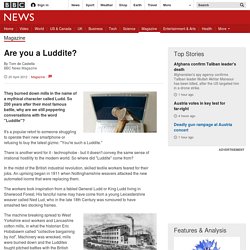
So 200 years after their most famous battle, why are we still peppering conversations with the word "Luddite"? It's a popular retort to someone struggling to operate their new smartphone or refusing to buy the latest gizmo: "You're such a Luddite. " There is another word for it - technophobe - but it doesn't convey the same sense of irrational hostility to the modern world. So where did "Luddite" come from? In the midst of the British industrial revolution, skilled textile workers feared for their jobs. The workers took inspiration from a fabled General Ludd or King Ludd living in Sherwood Forest. The machine breaking spread to West Yorkshire wool workers and Lancashire cotton mills, in what the historian Eric Hobsbawm called "collective bargaining by riot". Fascinating early photographs of London. 19c housing health. ECC-Carriages. Street Life in London. Page contents > John Thomson | PDF version | Images | Historypin Street Life in London, published in 1876-7, consists of a series of articles by the radical journalist Adolphe Smith and the photographer John Thomson.
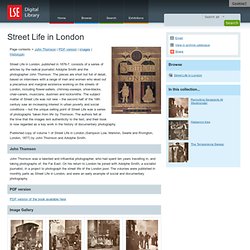
Famous Frosts and Frost Fairs in Great Britain:... Lady Hawarden's 19th century prints go on sale. Social pioneer's withering assessment deemed too offensive for her neighbours is published 100 years later. Graduate Maud Davies began a sociological study of her village in 1905Branded neighbours in Corsley, Wiltshire, 'rather rough' and 'a dirty lot'Villagers petitioned parish council to block paper from being publishedShe went on to expose 'white slave trade' in British prostitutes to the U.S.Ms Davies was found dead on a London Underground line at 37 By Kerry Mcdermott Published: 13:54 GMT, 13 March 2013 | Updated: 11:30 GMT, 14 March 2013.

Life of Ninteenth-Century Workers. [The following material comes from Readings in European History Since 1814, edited by Jonathan F.
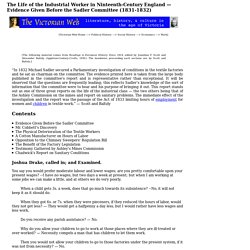
Scott and Alexander Baltzly (Appleton-Century-Crofts, 1930.) The headnotes preceeding each sections are by Scott and Baltzly.] Mugshots of Victorian thieves reveal an era of poverty when posing for a photograph was a special occasion. Fascinating police images were taken in Newcastle in the 1870sThey mostly feature petty thieves who stole everything from rabbits to champagneMugshots are part of Tyne and Wear Archives and Museums collection, which is being put online By Graham Smith Published: 10:15 GMT, 10 July 2012 | Updated: 14:25 GMT, 10 July 2012 Staring straight ahead, many with their right arm casually balanced on the back of a chair, these Victorian adults look lost deep in thought.

What their demure expressions fail to reveal, however, is that they are all posing for their police mugshot. Newly-published tax records of historical figures show Nelson payed just £3, Disraeli just £10 and King George II gave £47. 400 years of tax records released today show the rich, famous and royalty of previous centuries also paid paltry amounts to the TreasuryNelson, Conan Doyle, Disraeli and King George III handed over very small amounts of land tax despite owning plush homes, mansions and palaces By Martin Robinson Published: 10:29 GMT, 28 June 2012 | Updated: 12:08 GMT, 28 June 2012 Jimmy Carr can heave a huge sigh of relief - it has been revealed he is not the only celebrity to avoid handing over large amounts of cash to the tax man.
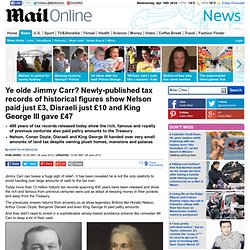
Today more than 12 million historic tax records spanning 400 years have been released and show the rich and famous from previous centuries were just as adept at keeping money in their pockets and away from the Treasury. The previously unseen returns from ancestry.co.uk show legendary Britons like Horatio Nelson, Arthur Conan Doyle, Benjamin Disraeli and even King George III paid paltry amounts. 1842 Royal Commission Reports - Raleys - Maps, Poems and Searchable Databases for Mining in the UK. The early nineteenth century saw a dramatic rise of activity in the mining of the country's coal fields.

1842_Yorkshir__1. 1842 Children's Employment Commission First Report of the Commissioners (Mines): From Weaver to Web. © Irish University Press Nature of employment in coal mines.

Halifax pages from Parliamentary Commission Report, incl images. 1842 Report - Scottish Mining Website. The Sadler Committee Report(1832) Sent to the asylum: The Victorian women locked up because they were suffering from stress, post natal depression and anxiety. By Wendy Wallace PUBLISHED: 21:00 GMT, 12 May 2012 | UPDATED: 11:09 GMT, 16 May 2012 These days, work stress, postnatal depression and anxiety are addressed with compassion.

But just a few generations ago, the women who suffered from these conditions, were confined to an asylum. The compelling portraits shown here, taken by Victorian photographer Henry Hering in the mid-19th century, have a haunting quality. But apart from the women’s pensive expressions and drab clothing, there is little to indicate that the photographs had been taken in an asylum. Emma Riches. Eliza Josolyne. Then, however, women could find themselves labelled insane and locked up in madhouses for a range of conditions – from postnatal depression to alcoholism or senile dementia, and even for social transgressions such as infidelity (‘moral insanity’).
History - Beneath the Surface: A Country of Two Nations. The History of Bristol. Bristol has a long and interesting history dating back to Anglo-Saxon times, when a settlement grew up between the Rivers Avon and Frome, known as Brigstowe (a place of settlement by the bridge).
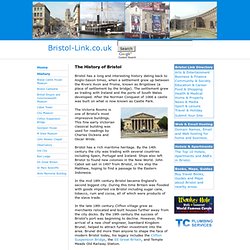
The settlement grew as trading with Ireland and the ports of South Wales developed. After the Norman Conquest of 1066 a castle was built on what is now known as Castle Park. Top 10 Creepy Aspects of Victorian Life. Creepy My birthday is on Monday so today I am in a mood of recollecting that life is short and we should live it to the full. In honor of the “life is short” bit, I have come up with a slightly depressing list (don’t worry – I will post a happier one tomorrow). The Victorians were a special breed and this list looks at 10 aspects of life from the Victorian era that are creepy. Note that the focus is entirely on Victorian England. Be sure to post any we have missed in the comments. The Victorian upper class (and later middle class) had no televisions to entertain them, so they entertained themselves. Poorhouses were government-run facilities where the poor, infirm, or mentally ill could live. History of Leeds - Poverty & Riches. During the 19th Century Leeds changed from a small town to a large manufacturing city, covered by a pall of smoke and fumes from the factory chimneys.
Between 1790 and 1840 there was a huge increase in numbers of the 'lower orders', who were now called the working classes. This was partly a result of the introduction of the factory system - factories like those of Benjamin Gott and John Marshall needed a large workforce. Also, the town was growing in prosperity, and attracting manufacturers, tradesmen, and shopkeepers, as well as those working in banking and property development.
All this commercial activity meant that people came to Leeds seeking work. There were not enough houses to accommodate all these people. In between the merchant elite and the lower orders of the 18th Century there had always been the craftsmen, shopkeepers and cloth workers who made up the middle classes. The Children of London's Spitalfields Slums in Photographs 100 Years Ago. Cholera in Wales in the 19th century. Wales (NLW Journals) Contents Cholera in Wales G Penrhyn Jones, National Library of Wales journal Vol X/3 Summer 1958. The Union Workhouse. These pages were started in October 1998 when there was no general information on workhouses on the Information Super-highway, as we used to call the Internet. This site begins with a simple description of workhouses; what they were & what life was like in them.
Further on, you will find information on several workhouses with links to important workhouse resources. To go straight to these, please click here. Rogues' gallery of Fagin's children: Mugshots of Victorian criminals shows thieves as young as 11 who were jailed for stealing clothes, cash and metal. Victorian Social History: An Overview.